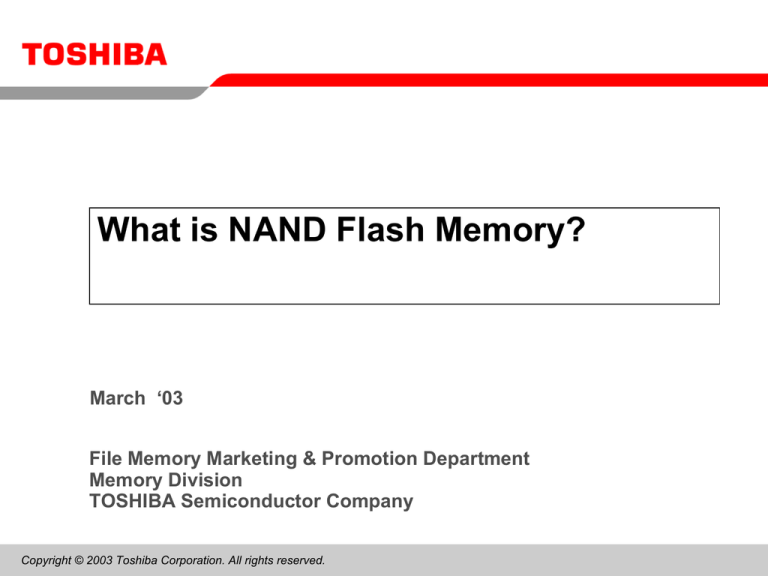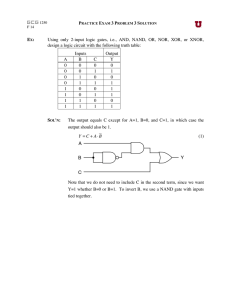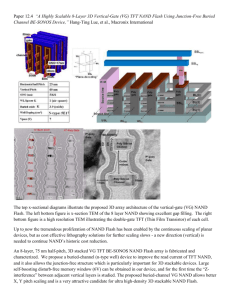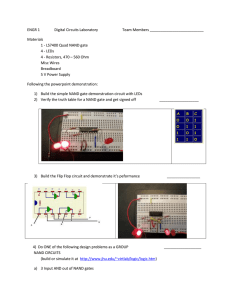
What is NAND Flash Memory?
March ‘03
File Memory Marketing & Promotion Department
Memory Division
TOSHIBA Semiconductor Company
Copyright © 2003 Toshiba Corporation. All rights reserved.
NAND Flash Memory Concept
/CE
/RE
/WE
R/BY
CLE
ALE
/WP
Suitable for file storage
System Bus
- File memory architecture
- Page programming (512 bytes/page)
High performance
NAND
Flash
I/O1 - I/O8
- High speed programming and erasing
Low cost
- Small chip size based on NAND Structure
- Small pin count
Easy memory expansion
- Simple interface by command control
CLE
/CE
/WE
ALE
I/O 1-8
CMD
Command
Input
Add
Add
Add
Address Input
NAND vs. NOR - Cell Structure
NAND
NOR
Bit line
Contact
Word line
Word line
Cell
Array
Unit Cell
Unit Cell
Source line
Source line
2F
2F
Layout
Crosssection
Cell size
5F
2F
4F2
10F2
NAND / NOR Characteristics
NAND
NOR
Capacity
~ 1Gbit (2chips/pkg)
~ 128Mbit
Power Supply
2.7-3.6V
I/O
x8
2.3-3.6V
x8/x16
Access Time
50ns(serial access cycle)
25µs(random access)
70ns(30pF, 2.3V)
65ns(30pF, 2.7V)
Program
Speed (typ.)
8µs/Byte
200µs/512Byte
4.1ms/512Byte
Erase
Speed(typ.)
2ms/Block (16KB)
700ms/Block
Prog+Erase(typ.)
33.6ms / 64KB
1.23s/Block (main:64KB)
NAND Flash Memory Block Diagram
ex.256Mb NAND Flash Memory
8bi
t
(512+16Byte)
Bit Line
Register
Basic unit
SG (D)
WL1
WL2
32page/Block
Page
WL3
WL4
~
~
(WL30)
Cell Array
512Byte
Redundant Cell
Array
16Byte
256Mb NAND Flash
Page Size : 512+16 Bytes
Block Size : 16KBytes
# of Blocks : 2048 Blocks
(WL31)
(WL32)
SG (S)
~
~
NAND Flash Memory Basic Function (1)
Read
Register
High Speed
Serial Read
1page Read
< Timing Chart>
CE
low
ALE
CLE
WE
RE
Command
I/O1~8
R/B
00H
Col
DN
Row1 Row2
Address Address Address
N
Wait(tR)
DN+1
Data-Out Data-Out
D527
Data-Out
(ex. 256Mb NAND Flash Memory)
NAND Flash Memory Basic Function (2)
Program
Register
Data Input
1page
Program
Page
Block
< Timing Chart >
CE
low
ALE
CLE
WE
RE
I/O1~8
R/B
high
Command
80H
Command
Col
Row1
Row2
D0
D1
D527
10H
Wait(tPROG)
Address Address Address Data-In
Data-In
Data-In
(ex. 256Mb NAND Flash Memory)
NAND Flash Memory Basic Function (3)
Erase
Register
Block Erase
(32page)
< Timing Chart >
CE
low
ALE
CLE
WE
RE
I/O1~8
R/B
high
Command
60H
Command
Row1
Row2
D0H
Wait(tERASE)
Address Address
(ex. 256Mb NAND Flash Memory)
NAND Flash Control in System
< Required Items >
1. NAND Flash File Management
- Bad Block Management
- Wear Leveling Treatment
2. ECC Support
- 1 bit/page error correction
and 2bit/page error detection**
* ECC : Error Correction Code
* * : 2LC NAND Flash 1bit/page ECC
Invalid block detection at Incoming
Number of valid blocks at shipping
Type.
Min.
TC58V64
1014
1024
TC58128
1004
1024
TC58256
2008
2048
TC58512
4016
4096
TH58100
8032
8192
Start
Max.
Block No = 1
Read Check
Block No. = Block
No. + 1
No
Fail
Pass
Bad Block *1
Block No. = Last Block
Yes
Invalid blocks have to be detected by
bad block test flow before erasing.
•
Invalid block
•
Valid block
: include “0” data. This “0”
data may be lost by erasing.
: has only “1” data.
End
< Read Check >
Read the 1st page of each block. If byte 517 of
the 1st page is not FF (Hex), define the block as
a bad block. The 1st block in the device is
guaranteed to be good at time of shipment.
*1 : No erase operation is allowed to bad blocks
NAND Flash Memory Basic Specification
0.16um
TC58V64BFT
64Mb
Density
TC58128AFT TC58256AFT
128Mb
256Mb
(8M+256K)x8 (16M+512K)x8 (32M+1M)x8
TC58512FT
TH58100FT
512Mb
1Gb
(64M+2M)x8 (128M+4M)x8
Operation voltage
2.7V-3.6V
←
←
←
←
Page size ( program unit )
512B+16B
←
←
←
←
Block size ( erase unit )
8KB+256B
16KB+512B
←
←
←
16
32
←
←
←
1024
1024
2048
4096
8192
3
←
←
4
←
Number of Pages per Block
Number of Blocks
Number of Address cycle
Random access time ( us )
25us (max.)
Serial access time ( ns )
50ns (min.)
Package
400mil / 0.8mm
TSOP type II
TSOP I 48-P-1220-0.50
2 Type Read Function
Type 1 (TSOP Package)
Sequential Read
/CE
(00H)
0
527
/WE
/RE
A
R/B
M
I/O
N
Busy
Data Output
00H
Sequential Read (1)
Sequential Read
Start-address input
Type 2 (BGA/MCP Package)
No Sequential Read
/CE don’t care
/CE
M
527
/WE
Select
page
N
/RE
R/B
I/O
M
N
Busy
Cell
array
Data Output
00H
Figure 3. Read mode (1)
operation
Start-address input
Next Add. Input
TSOP Package
Package Type
TSOP-II 44-P-400-0.8
VSS
CLE
ALE
WE
WP
44
43
42
41
40
1
2
3
4
5
VCC
CE
RE
R/B
OP
(L )
Top View
I/O 1
I/O 2
I/O 3
I/O 4
VSS
27
26
25
24
23
18
19
20
21
22
I/O 8
I/O 7
I/O 6
I/O 5
VCC
Stacked
Package
dimensions
&
Close
section View
&
Memory P/N
Single
(W)
18.41(L) x 11.76(W) x 1.2 (max) mm
64Mbit : TC58V64BFT
TSOP-I 48-P-1220-0.50
NC
NC
NC
NC
NC
OP
R/B
RE
CE
NC
NC
Vcc
Vss
NC
NC
CLE
ALE
WE
WP
NC
NC
NC
NC
NC
1
2
3
4
5
6
7
8
9
10
11
12
13
14
15
16
17
18
19
20
21
22
23
24
48
47
46
45
44
42
42
41
40
39
38
37
36
35
34
33
32
31
30
29
28
27
26
25
NC
NC
NC
NC
I/O8
I/O7
I/O6
I/O5
NC
NC
NC
Vcc ( L )
Vss
NC
NC
NC
I/O4
I/O3
I/O2
I/O1
NC
NC
NC
NC
(W)
12.0(L) x 20.0(W) x 1.2 (max) mm
128Mbit : TC58128AFT
256Mbit : TC58256AFT
512Mbit : TC58512FT
12.0(L) x 20.0(W) x 1.2 (max) mm
1Gbit : TH58100FT
CSP Outline Drawing
Package Size
Design rule
0.16um
0.13um
256M : 9mm X 11mm
7mm X 10mm
128M : 7mm X 10mm
7mm X 10mm
( 7x10 : no dummy ball )
256M/128M NAND Flash CSP
1.6
Top View
Bottom View
5.6
0.8
1.6
0.8
11
9
4.0
: Contact Balls
1.2max
0.47 typ.
: Index Mark Ball
: Dummy Balls
The information contained herein is subject to change without notice.
The information contained herein is presented only as a guide for the applications of our products. No responsibility is assumed
by TOSHIBA for any infringements of patents or other rights of the third parties which may result from its use.
No license is granted by implication or otherwise under any patent or patent rights of TOSHIBA or others.
TOSHIBA is continually working to improve the quality and reliability of its products.
Nevertheless, semiconductor devices in general can malfunction or fail due to their inherent electrical sensitivity and vulnerability
to physical stress.
It is the responsibility of the buyer, when utilizing TOSHIBA products, to comply with the standards of safety in making a safe design
for the entire system, and to avoid situations in which a malfunction or failure of such TOSHIBA products could cause loss of
human life, bodily injury or damage to property.
In developing your designs, please ensure that TOSHIBA products are used within specified operating ranges as set forth in the
most recent TOSHIBA products specifications.
Also, please keep in mind the precautions and conditions set forth in the “Handling Guide for Semiconductor Devices,” or
“TOSHIBA Semiconductor Reliability Handbook” etc.
The TOSHIBA products listed in this document are intended for usage in general electronics applications
(computer, personal equipment, office equipment, measuring equipment, industrial robotics, domestic appliances, etc.).
These TOSHIBA products are neither intended nor warranted for usage in equipment that requires extraordinarily high quality
and/or reliability or a malfunction or failure of which may cause loss of human life or bodily injury (“Unintended Usage”).
Unintended Usage include atomic energy control instruments, airplane or spaceship instruments, transportation instruments, traffic
signal instruments, combustion control instruments, medical instruments, all types of safety devices, etc.
Unintended Usage of TOSHIBA products listed in this document shall be made at the customer's own risk.
The products described in this document are subject to foreign exchange and foreign trade laws.
TOSHIBA products should not be embedded to the downstream products which are prohibited to be produced and sold, under any
law and regulations.




